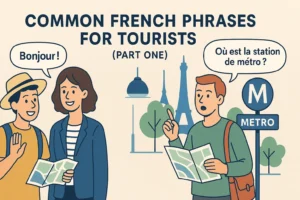Engaging Young Learners in a Distracting World
In today’s world, children are constantly bombarded with messages, notifications, and distractions that make it difficult for them to focus—especially in a classroom setting. Traditional learning environments often struggle to capture their attention, and keeping them engaged requires more than just textbooks and grammar exercises. To truly learn, kids need to have fun and feel motivated!
However, not just anyone can teach French to juniors. Teaching young learners requires a specific skill set, a deep understanding of what sparks their interest, and—most importantly—teachers who genuinely enjoy working with children. It’s not just about knowing the language; it’s about knowing how to make it come alive. The best teachers are those who have explored a full toolkit of engaging methods and who understand what excites and motivates young learners.
That’s why teaching French to juniors involves more than just lessons—it’s about creating experiences where kids actively use the language through play, creativity, and interaction. Our teachers and junior tutors know that when students see French as a tool for fun, expression, and connection, they naturally become more engaged and confident.
French as a Tool for Fun and Growth
Learning French isn’t just about memorizing vocabulary or grammar rules—it’s about making the language an exciting and useful tool in children’s daily lives. When kids understand that French can help them have fun, develop social skills, and gain confidence, they start seeing it as more than just a school subject.
This is why effective French teaching relies on a variety of tools—both digital and non-digital—that stimulate curiosity and interaction. Digital apps, interactive games, and online challenges can be great allies, but so can storytelling, theater, role-playing, and creative projects. Through these activities, our teachers ensure that students develop essential skills such as competitiveness, persuasive speech, social interaction, and storytelling in a fun and engaging way.
Effective Tools and Techniques for Teaching French to Kids
1. Kahoot! – Making Learning Competitive and Fun
- Description: A game-based learning platform that allows teachers to create quizzes and interactive activities.
- Sample Activity: Our teacher creates a fun quiz on French vocabulary related to daily routines. Students compete in real-time, reinforcing their word recall and comprehension skills while enjoying a friendly challenge.
- 👩🏫 Teacher Testimonial: “Implementing Kahoot! in my French classes has significantly increased student participation. The competitive element sparks excitement among students, and the immediate feedback helps them understand their mistakes in real-time.”
2. Genially & Escape Games – Learning Through Immersive Experiences
- Description: Genially allows teachers to create interactive and animated educational content. Escape games use problem-solving activities in French to engage students.
- Sample Activity: Our junior tutor designs an escape game where students solve French-language puzzles to “break out” of a virtual room. This method strengthens vocabulary and teamwork.
- 👨🏫 Teacher Testimonial: “Creating escape games using Genially has transformed my teaching approach. Students are more engaged and motivated to solve puzzles in French, which enhances their language skills in a fun and interactive way.”
3. Treasure Hunts in the City – Learning by Exploring
- Description: Real-world scavenger hunts encourage exploration and language use in authentic contexts.
- Sample Activity: Our junior tutor organizes a treasure hunt in the city, where students follow French-language clues to discover landmarks. This activity strengthens their vocabulary and builds confidence in using French outside the classroom.
4. BDnf (Bande Dessinée Nouvelle Forme) – Expressing Creativity Through Comics
- Description: A digital tool by the Bibliothèque nationale de France for creating comic strips.
- Sample Activity: Our teacher guides students in crafting their own comic strips in French, helping them practice creative writing, dialogue formation, and storytelling in an engaging way.
5. Canva – Designing Flyers to Develop Persuasive Speech
- Description: A graphic design platform that allows students to create visual content in French.
- Sample Activity: Our junior tutor asks students to design flyers for a fictional French cultural event, encouraging them to use persuasive language while integrating cultural elements into their work.
6. Cities: Skylines – Building a French-Speaking World
- Description: A city-building simulation game adapted for educational purposes.
- Sample Activity: Our teacher challenges students to design a French-speaking city, labeling structures and areas in French. This strengthens vocabulary related to urban planning while fostering creativity.
7. Barabistouille – Playful Learning Through Word Games
- Description: A French language game focusing on vocabulary and sentence structure.
- Sample Activity: Our junior tutor introduces a fun challenge where students create whimsical sentences using vocabulary cards. This game encourages them to experiment with syntax and express themselves in a playful way.
8. Magic Instant – Developing Storytelling Skills
- Description: An interactive storytelling tool that allows students to create and share stories in French.
- Sample Activity: Our teacher leads a collaborative storytelling session where each student adds a sentence or paragraph in French. This builds confidence in writing and speaking while fostering imagination.
Why These Methods Work
By integrating these tools into lessons, our teachers and junior tutors ensure that French learning is not only effective but also exciting. Through engaging activities, students discover that French is more than just a language it’s a tool for fun, creativity, and self-expression. As one teacher put it:
“I strive to give presentations and activities with real-life applications. For example, I had my intermediate students write thank-you cards to Notre-Dame firefighters, which motivated them and helped them connect with native speakers in a meaningful way.”
With the right techniques, learning French can be an adventure—one where students play, explore, and grow while gaining essential language skills.





